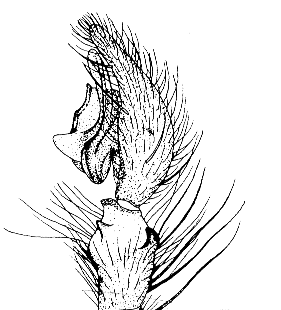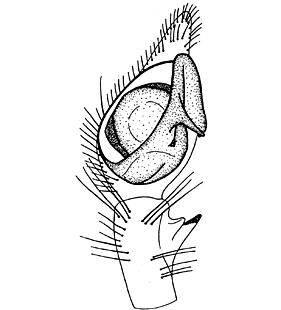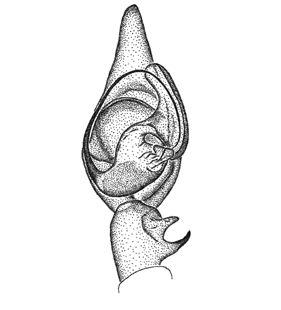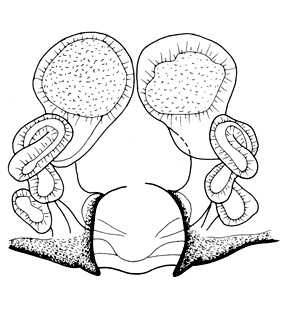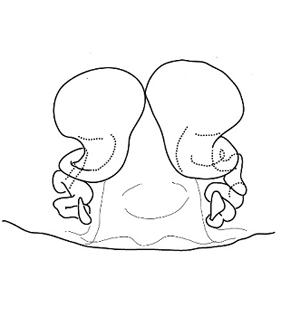Aterigena aliquoi (Brignoli, 1971)
Beschreibung
Männchen
RTA with a large dorsal branch, distally pointed and strongly sclerotized; lateral branch forming sclerotized finger-shaped appendix; ventrally bearing a weakly developed rounded ridge. Embolus originating (free apex) between 7 and 8 o’clock position; length (only the free apex) slightly more than twice cymbium width; distal tip between 3 and 4 o’clock position. Conductor lamella-like, distally elongated (parallel to cymbium), arcuated and laterally folded along the whole length; as long as alveolus, distally reaching beyond alveolus margin; terminal end forming sclerotized peak, pointing ventrally (in lateral view). Connection of conductor and tegulum membranous. Median apophysis consisting of membranous base and thin and broad sclerotized distal plate, pocket-like; originating between 4 and 5 o’clock position; protruding ventrally; basis as wide as median apophysis length. Tegular apophysis absent. Prosoma length: 6.78 mm. Opisthosoma length: 5.82 mm.
Weibchen
Epigynal plate sclerotized with a distinct atrium, reversed trapezoid in shape; anterior margin of atrium continuous change from sclerotized epigynal plate to membranous white skin. Ground plate of the atrium transversally divided: anterior part membranous and oval; posterior part forming strongly sclerotized semicircular bar. Receptacula visible through plate. Copulatory openings barely visible as gaps, located medial of atrium. Receptacula large, globular, touching each other; fertilization ducts very long and strongly convoluted. Prosoma length: 5.30 mm. Opisthosoma length: 6.00 mm.
Zusätzliche Informationen
Eyes: In frontal view PER procurved and AER slightly procurved. Diameters: PME: 0.19–0.23; PLE: 0.21–0.31; AME: 0.19–0.29; ALE: 0.29. Distances: PME–PME equal to diameter of PME; PME–PLE more than diameter of PME; PME–ALE about 1.5 diameter of PME. Clypeus height (measured under AME) less than 2.5 times diameter of AME; (measured under ALE) about 1.5 times diameter of ALE.
Coloration: two longitudinal symmetric darkened bands on carapace, interrupted and sometimes reduced to triangular dots, intensified by white and black plumose hairs. Opisthosoma with red-brown median band, slightly paler than in A. ligurica.
Additional somatic characters: Distal segment of PLS slightly longer than basal segment, both very weakly darkened.
Verbreitung
Phänologie
| Jan | Feb | Mar | Apr | May | Jun | Jul | Aug | Sep | Oct | Nov | Dec |
 |  |
Abbildungen
Verbreitungsnachweise
"No reference" bedeutet nicht, dass die Art in diesem Land nicht vorkommt, sondern dass wir die Referenz hierfür noch nicht eingefügt haben. Wir arbeiten daran.
Literatur
Bolzern A, Hänggi A, Burckhardt D (2010) Aterigena, a new genus of funnel-web spider, shedding some light on the Tegenaria-Malthonica problem (Araneae: Agelenidae) Journal of Arachnology 38: 162-182 ![]()
Brignoli P M (1971g) Contributo alla conoscenza degli Agelenidae Italiani (Araneae). Fragmenta Entomologica 8: 57-142 ![]()
Brignoli P M (1977b) Ragni d'Italia XXVII. Nuovi dati su Agelenidae, Argyronetidae, Hahniidae, Oxyopidae e Pisauridae cavernicoli ed epigei (Araneae). Quaderni del Museo di Speleologia "V. Rivera" 4: 3-117 ![]()
Pantini P, Isaia M (2019) Araneae.it: the online catalog of Italian spiders, with addenda on other arachnid orders occurring in Italy (Arachnida: Araneae, Opiliones, Palpigradi, Pseudoscorpionida, Scorpiones, Solifugae). Fragmenta Entomologica 51: 127-152 ![]()
Pesarini C (unpubl.)
WSC (2025) World Spider Catalog. Version 26. Natural History Museum Bern, online at http://wsc.nmbe.ch (28.2.2025) doi: 10.24436/2 ![]()
Updates
| 08-04-2021 | Distribution insert | Detail |
